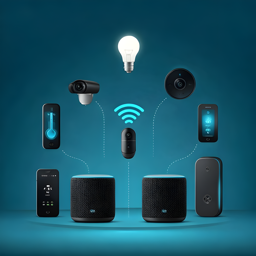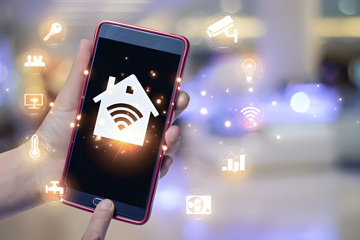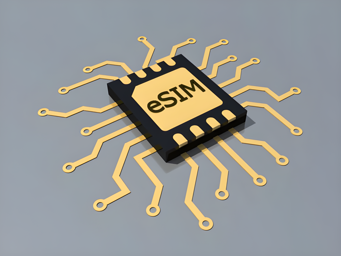Mastering ESP32 Connectivity: Wi-Fi, Bluetooth, and BLE
ESP32 BLE Server Tutorial: Custom GATT & Notifications
The ESP32’s built-in BLE capabilities make it ideal for creating low-power IoT devices that communicate with smartphones, sensors, or other peripherals. In this guide, we’ll build a BLE server (GATT server) with custom services, characteristics, and notifications, focusing on real-world use cases Zigbee Green Power: Ultra-Low-Power Energy Harvesting SolutionsDiscover how ZGP enables battery-free IoT devices through energy harvesting with ESP32 integrations, supporting smart home and industrial applications. like sensor data transmission and remote control.
Zigbee Green Power: Ultra-Low-Power Energy Harvesting SolutionsDiscover how ZGP enables battery-free IoT devices through energy harvesting with ESP32 integrations, supporting smart home and industrial applications. like sensor data transmission and remote control.
Table of Contents
- Understanding GATT
 Native Protocols: Wi-Fi (2.4 GHz), Bluetooth Classic, and BLEExplore ESP32 connectivity with Wi-Fi, Bluetooth Classic, and BLE. Learn implementation tips and best practices for IoT projects. Services and Characteristics
Native Protocols: Wi-Fi (2.4 GHz), Bluetooth Classic, and BLEExplore ESP32 connectivity with Wi-Fi, Bluetooth Classic, and BLE. Learn implementation tips and best practices for IoT projects. Services and Characteristics - Setting Up the BLE
 Native Protocols: Wi-Fi (2.4 GHz), Bluetooth Classic, and BLEExplore ESP32 connectivity with Wi-Fi, Bluetooth Classic, and BLE. Learn implementation tips and best practices for IoT projects. Server
Native Protocols: Wi-Fi (2.4 GHz), Bluetooth Classic, and BLEExplore ESP32 connectivity with Wi-Fi, Bluetooth Classic, and BLE. Learn implementation tips and best practices for IoT projects. Server - Implementing Notifications
- Security Best Practices
 Setting Up Wi-Fi Station Mode on ESP32Master the ESP32 Wi-Fi Station Mode with our guide featuring configuration steps, error handling, and power-saving tips for effective IoT projects.
Setting Up Wi-Fi Station Mode on ESP32Master the ESP32 Wi-Fi Station Mode with our guide featuring configuration steps, error handling, and power-saving tips for effective IoT projects. - Power Consumption
 Quick Comparison: Range, power consumption, costs, and complexity of each technologyDiscover the ideal wireless solution for your ESP32 IoT project by analyzing range, power, cost, and complexity. Optimize connectivity now. Optimization
Quick Comparison: Range, power consumption, costs, and complexity of each technologyDiscover the ideal wireless solution for your ESP32 IoT project by analyzing range, power, cost, and complexity. Optimize connectivity now. Optimization - Troubleshooting Common Issues
 Zigbee Over-the-Air (OTA) Firmware Updates with ESP32 CoordinatorsSecure your IoT network with OTA firmware upgrades using an ESP32 coordinator. Our guide details firmware setup, packaging, security, and troubleshooting.
Zigbee Over-the-Air (OTA) Firmware Updates with ESP32 CoordinatorsSecure your IoT network with OTA firmware upgrades using an ESP32 coordinator. Our guide details firmware setup, packaging, security, and troubleshooting. - Practical Applications
 Zigbee Green Power: Ultra-Low-Power Energy Harvesting SolutionsDiscover how ZGP enables battery-free IoT devices through energy harvesting with ESP32 integrations, supporting smart home and industrial applications.
Zigbee Green Power: Ultra-Low-Power Energy Harvesting SolutionsDiscover how ZGP enables battery-free IoT devices through energy harvesting with ESP32 integrations, supporting smart home and industrial applications.
Understanding GATT Services and Characteristics🔗
BLE Native Protocols: Wi-Fi (2.4 GHz), Bluetooth Classic, and BLEExplore ESP32 connectivity with Wi-Fi, Bluetooth Classic, and BLE. Learn implementation tips and best practices for IoT projects. uses the Generic Attribute Profile
Native Protocols: Wi-Fi (2.4 GHz), Bluetooth Classic, and BLEExplore ESP32 connectivity with Wi-Fi, Bluetooth Classic, and BLE. Learn implementation tips and best practices for IoT projects. uses the Generic Attribute Profile Native Protocols: Wi-Fi (2.4 GHz), Bluetooth Classic, and BLEExplore ESP32 connectivity with Wi-Fi, Bluetooth Classic, and BLE. Learn implementation tips and best practices for IoT projects. (GATT) to structure data into hierarchical elements:
Native Protocols: Wi-Fi (2.4 GHz), Bluetooth Classic, and BLEExplore ESP32 connectivity with Wi-Fi, Bluetooth Classic, and BLE. Learn implementation tips and best practices for IoT projects. (GATT) to structure data into hierarchical elements:
- Services: Containers for related functionalities (e.g., a Battery Service or Environmental Sensing Service).
- Characteristics: Data fields within a service (e.g., Temperature or Humidity).
- Descriptors: Metadata for characteristics (e.g., units, formats).
UUIDs uniquely identify services and characteristics. For custom profiles Enabling Bluetooth Classic on ESP32: Pairing, Profiles, and Data TransferExplore our comprehensive guide to enabling Bluetooth Classic on ESP32, covering pairing, SPP, A2DP, and reliable data transfer techniques., use UUIDs in the format
Enabling Bluetooth Classic on ESP32: Pairing, Profiles, and Data TransferExplore our comprehensive guide to enabling Bluetooth Classic on ESP32, covering pairing, SPP, A2DP, and reliable data transfer techniques., use UUIDs in the format 0000XXXX-0000-1000-8000-00805F9B34FB, replacing XXXX with a 16-bit value.
Example:
#define SERVICE_UUID "4fafc201-1fb5-459e-8fcc-c5c9c331914b"
#define CHARACTERISTIC_UUID "beb5483e-36e1-4688-b7f5-ea07361b26a8"
BLEService customService(SERVICE_UUID);
BLECharacteristic customChar(CHARACTERISTIC_UUID, BLENotify | BLERead | BLEWrite, 20);
- Here,
customCharsupports read/write operations and notifications.
Setting Up the BLE Server🔗
#include <BLEDevice.h>
void setup() {
BLEDevice::init("ESP32_BLE_Server");
BLEServer *server = BLEDevice::createServer();
server->setCallbacks(new ServerCallbacks()); // Handle connection events
}
Step 2: Create Services and Characteristics
BLEService *batteryService = server->createService(BLEUUID((uint16_t)0x180F)); // Battery Service
BLECharacteristic *batteryLevelChar = batteryService->createCharacteristic(
BLEUUID((uint16_t)0x2A19),
BLECharacteristic::PROPERTY_READ | BLECharacteristic::PROPERTY_NOTIFY
);
batteryLevelChar->addDescriptor(new BLE2902()); // Enable notifications
Step 3: Start Services
batteryService->start();
BLEAdvertising *advertising = server->getAdvertising();
advertising->start();
Implementing Notifications🔗
Notifications allow the server to push data to clients without polling.
Example: Sending battery level updates every 5 seconds:
void loop() {
uint8_t batteryLevel = readBatteryLevel(); // Custom function
batteryLevelChar->setValue(&batteryLevel, 1);
batteryLevelChar->notify();
delay(5000);
}
Key Points:
- Use
BLE2902descriptor to enable notifications. - Notifications are unacknowledged; use indications (acknowledged) for critical data.
Security Best Practices🔗
Secure your BLE Native Protocols: Wi-Fi (2.4 GHz), Bluetooth Classic, and BLEExplore ESP32 connectivity with Wi-Fi, Bluetooth Classic, and BLE. Learn implementation tips and best practices for IoT projects. server to prevent eavesdropping:
Native Protocols: Wi-Fi (2.4 GHz), Bluetooth Classic, and BLEExplore ESP32 connectivity with Wi-Fi, Bluetooth Classic, and BLE. Learn implementation tips and best practices for IoT projects. server to prevent eavesdropping:
BLESecurity *security = new BLESecurity();
security->setAuthenticationMode(ESP_LE_AUTH_REQ_SC_BOND);
2. Require Pairing:
batteryLevelChar->setAccessPermissions(ESP_GATT_PERM_READ_ENCRYPTED | ESP_GATT_PERM_WRITE_ENCRYPTED);
Power Consumption Optimization🔗
- Adjust Connection Intervals:
BLEDevice::setPower(ESP_PWR_LVL_N12); // Lowest transmit power
esp_ble_conn_update_params_t conn_params = {
.min_interval = 80, // 100 ms
.max_interval = 800, // 1 s
.latency = 0,
.timeout = 400 // 4 s
};
server->updateConnParams(&conn_params);
Troubleshooting Common Issues🔗
| Issue | Solution |
|---|---|
| Client can’t discover services | Verify UUIDs and service initialization order. |
| Notifications not working | Check if BLE2902 descriptor is added. |
| Intermittent disconnects | Increase connection timeout or reduce RF interference. |
Practical Applications🔗
1. Wireless Sensor Node:
BLECharacteristic tempChar("TEMPERATURE_UUID", BLENotify | BLERead, 4);
float temperature = readSensor();
tempChar.setValue(temperature);
tempChar.notify();
2. Smart Lock Controller:
BLECharacteristic lockCmdChar("LOCK_CMD_UUID", BLEWrite);
lockCmdChar.setWriteCallback([](BLECharacteristic* chr) {
uint8_t* cmd = chr->getData();
if (cmd[0] == 0x01) unlockDoor();
});
Understanding BLE Servers🔗
A BLE Native Protocols: Wi-Fi (2.4 GHz), Bluetooth Classic, and BLEExplore ESP32 connectivity with Wi-Fi, Bluetooth Classic, and BLE. Learn implementation tips and best practices for IoT projects. server, also known as a GATT
Native Protocols: Wi-Fi (2.4 GHz), Bluetooth Classic, and BLEExplore ESP32 connectivity with Wi-Fi, Bluetooth Classic, and BLE. Learn implementation tips and best practices for IoT projects. server, also known as a GATT Native Protocols: Wi-Fi (2.4 GHz), Bluetooth Classic, and BLEExplore ESP32 connectivity with Wi-Fi, Bluetooth Classic, and BLE. Learn implementation tips and best practices for IoT projects. server, is a device that hosts data and provides services to BLE clients
Native Protocols: Wi-Fi (2.4 GHz), Bluetooth Classic, and BLEExplore ESP32 connectivity with Wi-Fi, Bluetooth Classic, and BLE. Learn implementation tips and best practices for IoT projects. server, is a device that hosts data and provides services to BLE clients Setting Up BLE Client Communication on ESP32Learn how to configure the ESP32 as a BLE client. This guide explains scanning, connecting, and interacting with a variety of IoT devices effortlessly.. In the BLE architecture, the server exposes services and characteristics that clients can read, write, or subscribe to. For example:
Setting Up BLE Client Communication on ESP32Learn how to configure the ESP32 as a BLE client. This guide explains scanning, connecting, and interacting with a variety of IoT devices effortlessly.. In the BLE architecture, the server exposes services and characteristics that clients can read, write, or subscribe to. For example:
- A heart rate monitor exposes a heart rate service with a characteristic for the current heart rate value.
- A smart lock exposes a lock service with a characteristic for the lock state.
The server is responsible for:
- Defining services and characteristics.
- Handling client requests (e.g., read, write, notify).
- Sending notifications or indications to subscribed clients.
Defining GATT Services and Characteristics🔗
GATT (Generic Attribute Profile Native Protocols: Wi-Fi (2.4 GHz), Bluetooth Classic, and BLEExplore ESP32 connectivity with Wi-Fi, Bluetooth Classic, and BLE. Learn implementation tips and best practices for IoT projects.) is the backbone of BLE communication. Here’s how to define custom services and characteristics:
Native Protocols: Wi-Fi (2.4 GHz), Bluetooth Classic, and BLEExplore ESP32 connectivity with Wi-Fi, Bluetooth Classic, and BLE. Learn implementation tips and best practices for IoT projects.) is the backbone of BLE communication. Here’s how to define custom services and characteristics:
1. UUIDs:
- UUIDs are 128-bit identifiers that uniquely identify services and characteristics.
- Use online UUID generators or predefined UUIDs for standard BLE
 Native Protocols: Wi-Fi (2.4 GHz), Bluetooth Classic, and BLEExplore ESP32 connectivity with Wi-Fi, Bluetooth Classic, and BLE. Learn implementation tips and best practices for IoT projects. profiles (e.g., heart rate, battery level).
Native Protocols: Wi-Fi (2.4 GHz), Bluetooth Classic, and BLEExplore ESP32 connectivity with Wi-Fi, Bluetooth Classic, and BLE. Learn implementation tips and best practices for IoT projects. profiles (e.g., heart rate, battery level).
2. Properties:
- READ: Clients can read the characteristic value.
- WRITE: Clients can write to the characteristic.
- NOTIFY: Server can send updates to clients without acknowledgment.
- INDICATE: Server sends updates, and clients must acknowledge receipt.
3. Descriptors:
- Descriptors provide additional metadata about characteristics.
- Example: The
BLE2902descriptor enables notifications/indications.
Practical Example: IoT Sensor Data Transmission🔗
Let’s build a practical example where the ESP32 Setting Up ESP32 as a Wi-Fi Access PointMaster ESP32 AP configuration with our step-by-step guide. Set up a secure, local IoT network using practical code examples and optimization tips. acts as a BLE server transmitting sensor data (e.g., temperature):
Setting Up ESP32 as a Wi-Fi Access PointMaster ESP32 AP configuration with our step-by-step guide. Set up a secure, local IoT network using practical code examples and optimization tips. acts as a BLE server transmitting sensor data (e.g., temperature):
1. Define a Temperature Service:
BLEService *pTempService = server->createService("00001809-0000-1000-8000-00805f9b34fb");
BLECharacteristic *pTempCharacteristic = pTempService->createCharacteristic(
"00002a1c-0000-1000-8000-00805f9b34fb",
BLECharacteristic::PROPERTY_READ |
BLECharacteristic::PROPERTY_NOTIFY
);
pTempCharacteristic->addDescriptor(new BLE2902());
Simulate temperature readings and notify clients.
float temperature = readTemperatureSensor();
pTempCharacteristic->setValue(temperature);
pTempCharacteristic->notify();
Security Considerations🔗
BLE communication Setting Up BLE Client Communication on ESP32Learn how to configure the ESP32 as a BLE client. This guide explains scanning, connecting, and interacting with a variety of IoT devices effortlessly. can be vulnerable to eavesdropping and unauthorized access. Secure your BLE server with:
Setting Up BLE Client Communication on ESP32Learn how to configure the ESP32 as a BLE client. This guide explains scanning, connecting, and interacting with a variety of IoT devices effortlessly. can be vulnerable to eavesdropping and unauthorized access. Secure your BLE server with:
- LE Secure Connections: Use pairing with encryption
 Connecting ESP32 to Cloud Services via Wi-FiDiscover how to connect your ESP32 to AWS, Azure, and Google Cloud using secure Wi-Fi. This guide covers setup, error handling, and low power strategies..
Connecting ESP32 to Cloud Services via Wi-FiDiscover how to connect your ESP32 to AWS, Azure, and Google Cloud using secure Wi-Fi. This guide covers setup, error handling, and low power strategies.. - Bonding: Store paired device keys for future connections.
- MITM Protection: Enable Man-in-the-Middle protection for sensitive applications.
Optimizing Power Consumption🔗
BLE is designed for low power Connecting ESP32 to Cloud Services via Wi-FiDiscover how to connect your ESP32 to AWS, Azure, and Google Cloud using secure Wi-Fi. This guide covers setup, error handling, and low power strategies., but you can further optimize:
Connecting ESP32 to Cloud Services via Wi-FiDiscover how to connect your ESP32 to AWS, Azure, and Google Cloud using secure Wi-Fi. This guide covers setup, error handling, and low power strategies., but you can further optimize:
- Connection Intervals: Increase intervals to reduce power consumption
 Quick Comparison: Range, power consumption, costs, and complexity of each technologyDiscover the ideal wireless solution for your ESP32 IoT project by analyzing range, power, cost, and complexity. Optimize connectivity now..
Quick Comparison: Range, power consumption, costs, and complexity of each technologyDiscover the ideal wireless solution for your ESP32 IoT project by analyzing range, power, cost, and complexity. Optimize connectivity now.. - Advertising Intervals: Use longer intervals when not actively connecting.
- Sleep Modes: Combine BLE with ESP32’s deep sleep mode
 SIM7000G Module with ESP32: Configuring LTE-M and GNSSMaster ESP32 integration with SIM7000G for reliable LTE-M connectivity and precise GPS tracking, featuring hardware setup, AT commands, and power tips. for battery-powered devices.
SIM7000G Module with ESP32: Configuring LTE-M and GNSSMaster ESP32 integration with SIM7000G for reliable LTE-M connectivity and precise GPS tracking, featuring hardware setup, AT commands, and power tips. for battery-powered devices.
Conclusion🔗
Creating a BLE server on the ESP32 opens up a world of possibilities for IoT applications Connecting ESP32 to Cloud Services via Wi-FiDiscover how to connect your ESP32 to AWS, Azure, and Google Cloud using secure Wi-Fi. This guide covers setup, error handling, and low power strategies.. By defining custom services and characteristics, implementing notifications, and optimizing for power and security, you can build robust, low-power BLE solutions. Whether you're transmitting sensor data or controlling smart home devices, the ESP32’s BLE capabilities make it a versatile choice for your next project.
Connecting ESP32 to Cloud Services via Wi-FiDiscover how to connect your ESP32 to AWS, Azure, and Google Cloud using secure Wi-Fi. This guide covers setup, error handling, and low power strategies.. By defining custom services and characteristics, implementing notifications, and optimizing for power and security, you can build robust, low-power BLE solutions. Whether you're transmitting sensor data or controlling smart home devices, the ESP32’s BLE capabilities make it a versatile choice for your next project.
Enjoy integrating BLE Native Protocols: Wi-Fi (2.4 GHz), Bluetooth Classic, and BLEExplore ESP32 connectivity with Wi-Fi, Bluetooth Classic, and BLE. Learn implementation tips and best practices for IoT projects. into your projects and explore further enhancements such as secure pairing and multi-device mesh configurations in your next steps!
Native Protocols: Wi-Fi (2.4 GHz), Bluetooth Classic, and BLEExplore ESP32 connectivity with Wi-Fi, Bluetooth Classic, and BLE. Learn implementation tips and best practices for IoT projects. into your projects and explore further enhancements such as secure pairing and multi-device mesh configurations in your next steps!
Author: Marcelo V. Souza - Engenheiro de Sistemas e Entusiasta em IoT e Desenvolvimento de Software, com foco em inovação tecnológica.
References🔗
- Arduino Forum: forum.arduino.cc
- Arduino IDE Official Website: arduino.cc
- ESP-IDF Programming Guide: docs.espressif.com/projects/esp-idf
- ESP32 Arduino Core Documentation: docs.espressif.com/projects/arduino-esp32
- Espressif Documentation: docs.espressif.com

 9 months ago
9 months ago
 9 months ago
9 months ago
 9 months ago
9 months ago
 9 months ago
9 months ago
 9 months ago
9 months ago
 9 months ago
9 months ago
 10 months ago
10 months ago
 9 months ago
9 months ago
 9 months ago
9 months ago
 9 months ago
9 months ago
 9 months ago
9 months ago
 9 months ago
9 months ago
 9 months ago
9 months ago
 9 months ago
9 months ago
 9 months ago
9 months ago
 9 months ago
9 months ago
 9 months ago
9 months ago
 9 months ago
9 months ago
 9 months ago
9 months ago
 9 months ago
9 months ago
 9 months ago
9 months ago